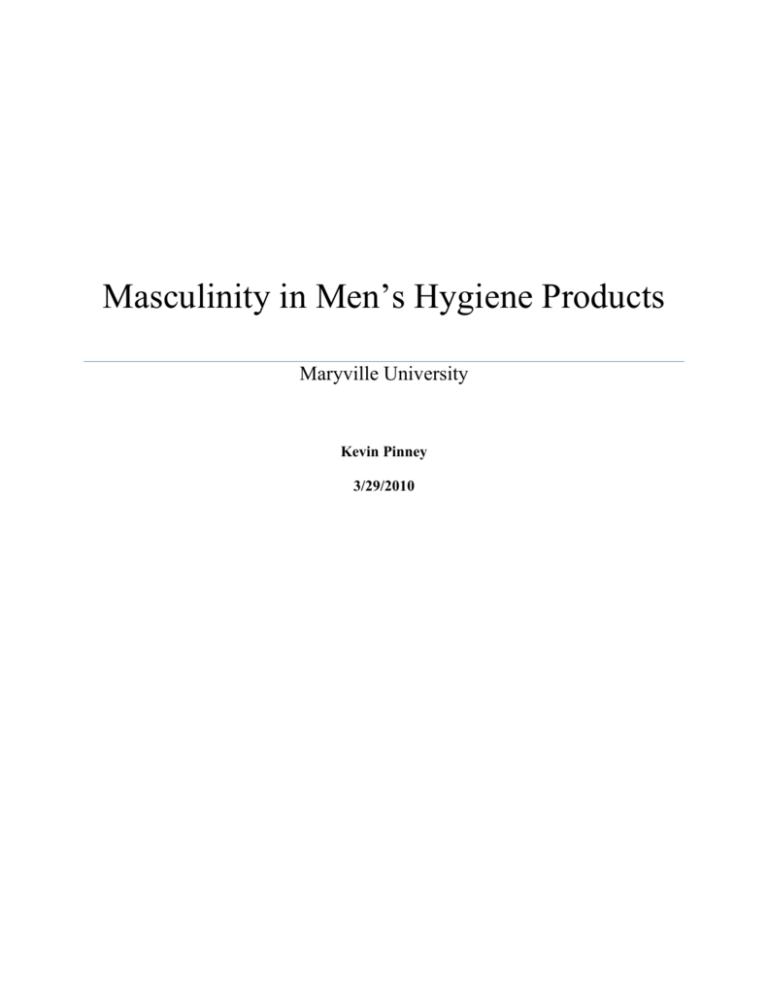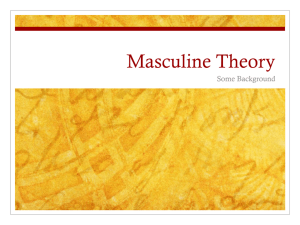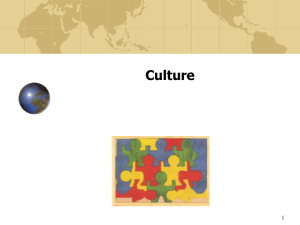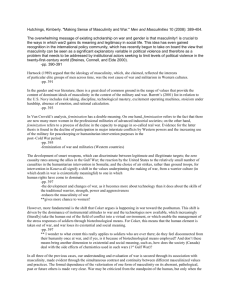Masculinity in Men*s Hygiene Products
advertisement

Masculinity in Men’s Hygiene Products Maryville University Kevin Pinney 3/29/2010 2 Masculinity in Men’s Hygiene Products ABSTRACT This paper is a content analysis of various video advertisements for men’s hygiene products. The advertisements create three different templates for masculinity. Men can use these products to be “seducers” where their masculinity rides on the ability to attract females for sex. Men can also be hypermasculine, where certain characteristics are exaggerated to either critique stereotypical masculinity, or to make to seem desirable. Finally, men can be a sort of “new man” where they’re comfortable with themselves, and want a no-nonsense way to just stay clean and have nice skin. Regardless, all advertisements have the same goal in mind to convince men that their product is the manliest. I argue that it is in fact the definition of “manly” that is at stake in these three categories, as corporations actively negotiate the different expressions of contemporary masculinity to see which one is most compelling to their demographic. 3 Masculinity in Men’s Hygiene Products Masculinity in Men’s Hygiene Products There once was a time when masculinity meant chopping down trees in the forest, or working in the field all day tending crops. Those days are gone as more men in the United States have service jobs and their careers require sitting in a cubicle typing all day instead of getting sweaty and using muscle. To reclaim this sort of lost masculinity, marketers of men’s hygiene products portray men as hypermasculine, “seducers,” and “new men.” All three models work to convey a message of what masculinity means in the contemporary world. This content analysis examines fifteen advertisements for men’s hygiene products. Of the advertisements, six were from Axe, four were from Old Spice, two were from Dove and Tag, and one was from Nivea. All advertisements were aired on domestic television in the past three years with the exception of one music video produced by Axe, which was created for internet viewing. All of them depict what masculinity is, should, or could be to their target demographics. Of the advertisements, all use exaggeration, and all but one use humor to convey their intended messages. Ten of the fifteen productions contained sexual overtones. Of the advertisements analyzed, eight followed the “seducer” archetype. Reduced to their most basic elements, they feature a male that uses the product, and women who thus become attracted to that man. In Axe’s “Operation Piggy” thirty second television spot, for instance, young women set loose a pig in a mall and tell it to “find us a dirty boy.” The pig runs around and finds and tackles a guy with greasy hair, and the women proceed to wash his hair and “beautify” him. The ad ends with one of the girls saying “94 percent of girls think greasy, dirty hair is a turnoff.” According to this advertisement, boys should be clean so girls like them. There is also a trend in other Axe advertisements of showing boys how to apply the 4 Masculinity in Men’s Hygiene Products product. For example, “Double Pits to Chesty” shows young men how to apply axe in the form of a motocross stunt. While doing a back flip on the bike, the stuntman sprays both armpits with axe, then sprays a diagonal line of it across his chest right before landing the jump. While interviewing him after the stunt, the attractive woman reporter gets in close and breathes in his seductive scent. This assures young men that using scented products is indeed masculine, and doing so will lead to success in the sack. It also establishes a younger, thrill-seeking version of masculinity for men to emulate. Axe’s “Bury” advertisement fits this younger masculinity by featuring a young male that walks by a girl at a house party. She smells him, follows him into the kitchen, bends him over, and starts rubbing and smelling his hair. According to the ad, Axe has a magical effect on women, and makes them sexually aggressive pseudo-rapists. As a result, very little effort is required for Axe users to seduce them. Axe labels this occurrence as the “Axe Effect” which has become the company’s tagline. To illustrate this effect in-depth, Axe produced the music video “Bow Chicka Wow Wow” starring three scantily clad women dancing around in a girl’s brain when she smells a nearby young man’s Axe-laden body. The women urge the girl to listen to her libido and symbolically destroy the walls in her brain holding her back. They sing of breathing in “the mist” and letting loose. The ad ends with the girl surrendering to her libido’s urges and coming onto the man that wears the Axe by grinding on him and kissing his neck. The “Bom Chicka Wow Wow” video is connected to a similar set of advertisements that follow a similar theme. “Axe Chimps” shows a young couple watching chimps on television groom each other. The girl tells the boy, “This is really putting me in the mood,” and starts to rub his hair in mimicry of the chimps. “Axe Skin Contacts” features a freshly showered young man play wrestling with his girlfriend. She started the wrestling once she caught a whiff of his Axe scented body. These sexually charged advertisements present an 5 Masculinity in Men’s Hygiene Products immature masculinity that revolves around attracting women. Axe makes “manly” accessible to men by making it easier to seduce women. Tag has a slightly less refined approach to this. The company created ads that imitated public service announcements that end with the tagline, “Consider yourself warned.” For example, in the “Poker Game” television spot, a teenage male applies tag body spray, goes down to the basement where he rejoins a game of poker he has been playing with three girls. He says, “I got nothing” and sets down his cards. The girls look at each other, and one says, “Don’t worry about it.” The girls stand up and start to lift their shirts up. At that moment, one of the girl’s father comes down and see what’s going on. He starts to chase the boy, and the commercial cuts to a warning that states “…a full house beats a flush, and an angry dad, well, he’ll beat you straight up.” This ad leaves nothing to the imagination, but follows the same trend of exaggerating situations and using humor to connect with the young male demographic. In “The Mom,” Tag illustrates the common occasion when a high school girl’s boyfriend shows up at the house while she’s still getting ready to go out. The boy is wearing tag and when the girl’s mom answers the door, she instantly notices his seductive scent. She comes onto him with lines like, “I like your haircut like that,” and “Call me Bonnie,” as she pushes her breasts close to him and pops a button on her shirt. Tag portrays seducers as so “manly,” they don’t need to even try to get women – young or old. These ads exemplify the majority of Axe and Tag advertisements, but Old Spice made its own version of a “seductive” male. Instead of being set in a place like the mall, at a house party, or in a basement, the ad is set on a beach. There is a beautiful woman in her late twenties and she’s fully clothed. An older man sits down by her, asks her if she knows how many scents Old Spice makes, then kisses her. She pulls a folded piece of paper out of her mouth, reads it, and 6 Masculinity in Men’s Hygiene Products says, “Wow! That’s a lot!” as he nods knowingly. Unlike Tag and Axe ads where the viewer is submersed in sexual messages, Old spice takes a more subtle approach. The man has a more mature, East Coast sophistication with his behavior and dress. There is no hunt for sex with him because he already has the girl, but he maintains that seductive image. This ad thus blurs into the second category, hypermasculinity, where the construction of the seducer is humorously challenged, but not disregarded entirely. While Axe and Tag campaigns were dominated with the “seductive” man, Old Spice mastered over-the-top manliness and used this archetype in the majority of its advertisements. The advertisements feature successful, attractive men that emphasize experience. The best example of this is in the 2007 television spot featuring Bruce Campbell, hypermasculine star of cult films like Army of Darkness (1992). It’s set in a richly furnished room, and appears to be a study in a very expensive yacht. As he walks around the room, he talks about “it.” He says things like, “If you need it, you don’t have it… You can share it, sure, you can even stockpile it if you’d like. But you can’t fake it…” The ad never tells what he is talking about until the very end, where he reaches his starting point and “Experience is everything” appears on screen as the cold fireplace relights and the Old Spice whistle plays. He walked around a circular room with no door, and when he reached the end (also his starting point) everything was in mirror image. In this ad, Bruce epitomizes hypermasculinity. He’s experienced, wealthy, likes to sail, and successful. But, because he’s Bruce, he takes those masculine elements in this commercial and amplifies them to the hypermasculine level. Old Spice continued to emphasize experience in the “Manly Test” television spot released later that year. This ad features a man in a locker room saying Old Spice is the right choice for men, and has a side by side demonstration of Old Spice versus the “other brand.” In the test, both deodorants are applied to a bare chest. Old Spice goes 7 Masculinity in Men’s Hygiene Products on clear and smooth, while the “other brand” goes on clumpy. A moment after they’re swiped, hair magically sprouts from the naked chest on the Old Spice side. Below that, “Manly” appears. The setting and the hair define masculinity in an exaggerated manner. At the same time, it debases the belief that masculinity is based on the ability to seduce women. If the man is manly, only then will seduction be possible. More recently, in 2010, Old Spice released two new ads still sticking to the hypermasculine archetype. The first, “Armpit Mountain,” sets a very tonguein-cheek tone when the narrator asks questions like, “Is winning a habit you can’t seem to quit? Is failure one game you refuse to win? Is handsomeness a burden your face has to life with every day?” Meanwhile, the commercial shows a man lifting weights, being measured for a suit, and cutting chicken and arranging it on a plate so it looks like his date’s face. The new scent “Matterhorn” is introduced and it’s “A triumphantly fresh scent that smells like the world’s most successful mountain.” Old Spice is defining strength, dressing well, knowing how to treat a lady, and success as masculine traits. While these characteristics are not outlandish, the way they are presented with visuals in the advertisement are. Old Spice’s hypermasculine advertisements also place an emphasis on maturity by using actors that look older than thirty. Other advertisers embrace maturity as the core masculine trait. Nivea’s “For Grownups” commercial, for example, shows teens sniffing Nivea for Men Bodywash. Their reactions range from, “This won’t increase my ability to mate,” to “They need to feel me, they need to hear me, they need to see me, above all they gotta to smell me. You know? They need to be attracted somehow.” The ad clearly pokes fun at the sophomoric Axe and Tag advertisements in the first half. The second half features a thirty-something man checking it out and saying, “It doesn’t dry out your skin. It doesn’t reek. Isn’t that the point?” The commercial then cuts to text “Bodywash for Grownups.” This no-nonsense approach to men’s hygiene is something that neither 8 Masculinity in Men’s Hygiene Products “seducer” nor hypermasculine advertisers embraced, but it does draw from the ironic approach of the hypermasculine ads. Nivea boils hygiene down to its most basic element: getting clean. Dove builds on this concept with its “Journey to Comfort” advertisement. It outlines the average man’s life starting at birth, climbing the rope in gym class, getting married, checking out strange sounds at night, having kids and doing yard work. The music is “William Tell Overture” and it’s redubbed to narrate all of these milestones. The narrator sums it up by singing, “You’ve come this far and it wasn’t a breeze. You can take on anything; of course you can, because you’re a man!” He stop singing and continues, “Now that you’re comfortable with who you are, isn’t it time for comfortable skin?” This ad sends the message that it’s not feminine for men to treat themselves to soft skin; on the contrary, it’s the manly thing to do. Dove also illustrates basic masculine traits in its “Men+Care Deodorant” ad. It opens with a man in a black Maserati and pans back to a baby in the back seat. As this happens, the narrator says, “Who says power can’t be caring?” Men like expensive, fast cars, but they’re also supposed to be the caretakers of the family. The ad shows a modern man fulfilling his role in society. Each of these advertisements reject scent as an important part of masculinity, instead they emphasize soft, healthy skin. They also portray men in the most “normal” manner out of the three types of masculinity. Contemporary manliness can no longer be defined as being burly, sweaty, and hairy. Advertisers of men’s hygiene products portray masculinity in three different lights. Seducers are “manly” because they are able to seduce women. Hypermasculine men are overflowing with “manly” traits like brawn, success, and experience. The “new man” portrayal is the most realistic approach to modern manliness. It takes the first two versions of masculinity, tones them down, and illustrates them with everyday life. Nevertheless, the first two depictions exist for 9 Masculinity in Men’s Hygiene Products marketers to connect with their target demographics. They give viewers something with which to relate or to revere.








